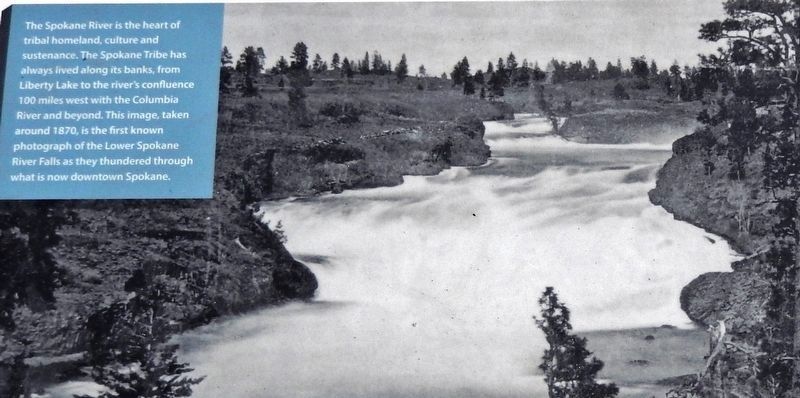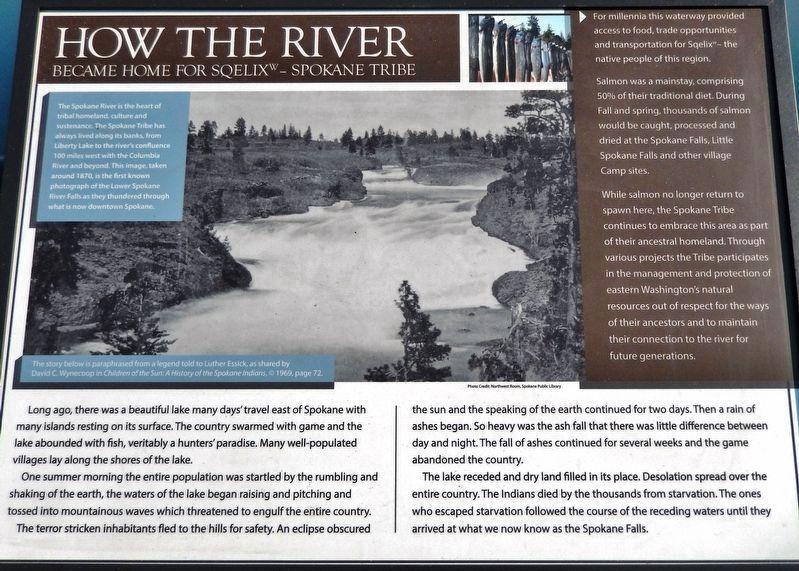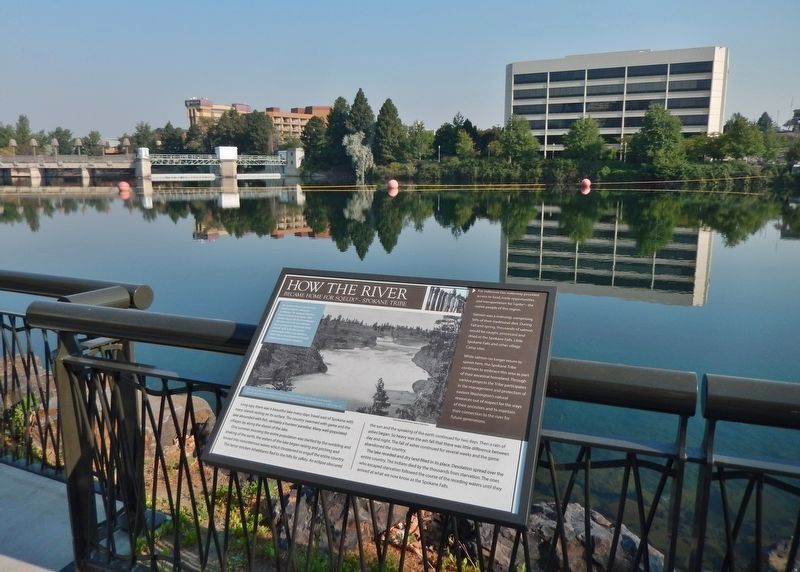Spokane in Spokane County, Washington — The American West (Northwest)
How the River Became Home for Sqelix — Spokane Tribe
Inscription.
The story below is paraphrased from a legend told to Father Essick, as shared by David C. Wynecoop in Children of the Sun: A History of the Spokane Indians, ©1969, page 72.
Long ago, there was a beautiful lake many days' travel east of Spokane with many islands resting on its surface. The country swarmed with game and the lake abounded with fish, veritably a hunters' paradise. Many well-populated villages lay along the shores of the lake.
One summer morning the entire population was startled by the rumbling and shaking of the earth, the waters of the lake began raising and pitching and tossed into mountainous waves which threatened to engulf the entire country.
The terror stricken inhabitants fled to the hills for safety. An eclipse obscured the sun and the speaking of the earth continued for two days. Then a rain of ashes began. So heavy was the ash fall that there was little difference between day and night. The fall of ashes continued for several weeks and the game abandoned the country.
The lake receded and dry land filled in its place. Desolation spread over the entire country. The Indians died by the thousands from starvation. The ones who escaped starvation followed the course of the receding waters until they arrived at what we now know as the Spokane Falls.
[sidebar]
For millennia this waterway provided access to food, trade opportunities and transportation for Sqelix — the native people of this region.
Salmon was a mainstay, comprising 50% of their traditional diet. During Fall and spring, thousands of salmon would be caught, processed and dried at the Spokane Falls, Little Spokane Falls and other village Camp sites.
While salmon no longer return to spawn here, the Spokane Tribe continues to embrace this area as part of their ancestral homeland. Through various projects the Tribe participates in the management and protection of eastern Washington's natural resources out of respect for the ways of their ancestors and to maintain their connection to the river for future generations.
Topics. This historical marker is listed in these topic lists: Native Americans • Waterways & Vessels. A significant historical year for this entry is 1870.
Location. 47° 39.712′ N, 117° 24.784′ W. Marker is in Spokane, Washington, in Spokane County. Marker can be reached from North Spokane Falls Court, 0.1 miles north of West Spokane Falls Boulevard. Marker is located along the Centennial Trail, overlooking the Spokane River, on the north side of the Spokane Convention Center. Touch for map. Marker is at or near this postal address: 334 West Spokane Falls Boulevard, Spokane WA 99201, United States of America. Touch for directions.
Other nearby markers. At least 8 other markers are within walking distance of this marker

Courtesy Northwest Room, Spokane Public Library
2. Marker detail: Spokane River Falls, circa 1870
The Spokane River is the heart of tribal homeland, culture and sustenance. The Spokane Tribe has always lived along its banks, from Liberty Lake to the river's confluence 100 miles west with the Columbia River and beyond. This image, taken around 1870, is the first known photograph of the Lower Spokane River Falls as they thundered through what is now downtown Spokane.
Also see . . . Spokane people (Wikipedia). The Spokan or Spokane people are a Native American Plateau tribe who have inhabited the eastern portion of present-day Washington state and parts of northern Idaho in the United States of America. The city of Spokane, Washington (Sʎˈetkʷ) is named after the tribe. It developed along the Spokane River, within the historic ancestral land of the tribe. For thousands of years the Spokane people lived near the Spokane River in the territory of present-day eastern Washington and northern Idaho, surviving by hunting and gathering. (Submitted on April 20, 2020, by Cosmos Mariner of Cape Canaveral, Florida.)
Credits. This page was last revised on April 23, 2020. It was originally submitted on April 20, 2020, by Cosmos Mariner of Cape Canaveral, Florida. This page has been viewed 230 times since then and 23 times this year. Photos: 1, 2, 3. submitted on April 20, 2020, by Cosmos Mariner of Cape Canaveral, Florida.

